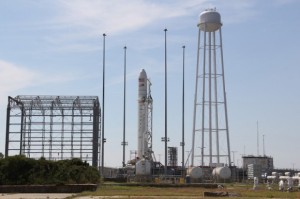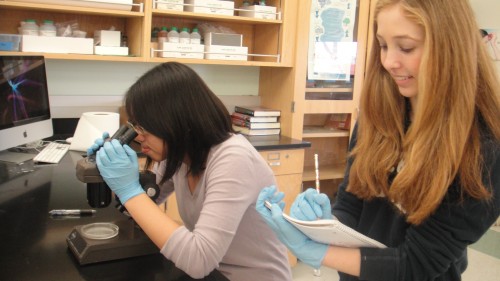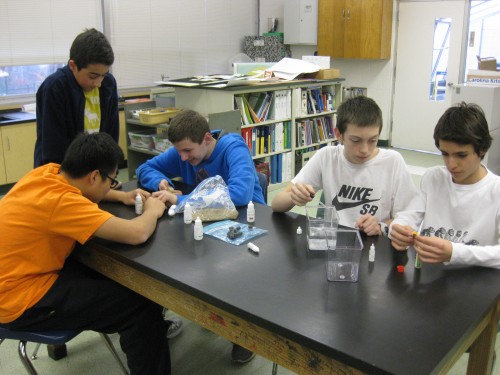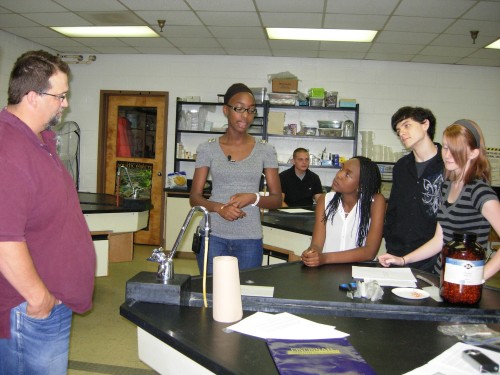As this post is being published, we are now at T minus 1 Day, 2 Hours, 10 minutes from liftoff.
The Mission 3 to ISS clock at right is ticking down to the currently scheduled launch of the Orbital Sciences Antares rocket on Wednesday, September 18 (see the NASA Consolidate Launch Schedule) – the mission: Orb-D1. Antares will be blasting off at 10:50 am ET from the Mid-Atlantic Regional Spaceport (MARS), Wallops Island, VA, a truly historic launch, and we have delegations of student researchers, teachers, and family members that will be at the launch site (see the Launch Viewing Plans for Orb-D1 page).
Atop the rocket is the Cygnus spacecraft, and aboard her is the SSEP Falcon I payload of 7 experiments. Student flight experiment teams around the nation – 5 teams for Mission 3 experiments, 1 team for a Mission 1 re-flight experiment, and 1 team for a Mission 2 re-flight experiment – are standing by to watch the launch, and begin on-orbit operations aboard the International Space Station.
In addition Mission Patches from all 17 SSEP Mission 3 to ISS communities will be launching with the Falcon I experiments payload. We will have a separate blog post dedicated to the Mission Patches next week.
We are therefore honored to present information on all 7 experiments launching Wednesday. Provided for each experiment listed below are the names of the student research team and teacher facilitator, an abstract of the experiment, and a list of all the organizational partners that made SSEP possible for the community. In addition, for student teams that presented at the annual SSEP National Conference at the Smithsonian National Air and Space Museum, a video clip of their presentation is also provided below.
It is worthy to note that across the 17 Mission 3 to ISS communities, at total of 7,200 students were fully engaged in experiment design, and 1,466 flight experiment proposals were received from student teams. The Mission 3 to ISS Step 2 Review Board, which met at the National Air and Space Museum on November 27-28, 2012, selected one flight experiment for each community. Five of the Mission 3 experiments fly tomorrow. The remaining 12 experiments are scheduled to fly on the Orbital Sciences 1 mission (Orb-1) late in 2013.
(for more information, contact: 301-395-0770, jeffgoldstein@ncesse.org)
Mission 3 to ISS Experiments
1. San Marino, California
Fibroblast Division in Microgravity
Grade 11, San Marino High School
Co-Principal Investigators: Jennifer Jiang, Jasmine Kuo, and Kara Lukas
Teacher Facilitator: Wyeth Collo, Science Department Chairman, Biology Instructor
Summary:
Cell division is an integral component of life; all organisms must go through the cell cycle in order to grow, develop, and reproduce. Past experiments that have been conducted on Earth in simulated microgravity have shown that the lack of gravity causes cells to divide at a slower rate. We have decided to conduct further research concerning this topic and perform an experiment which will hopefully yield favorable results for science and humankind. The purpose of our experiment is to observe the effect of microgravity on cell division and to compare the rates of cell division in the absence and presence of gravity, which is dependent on the number of cells produced. The cells that we have chosen to experiment with are fibroblasts, which play a critical role in the healing of wounds. To test our experiment, the fibroblasts will be exposed to microgravity as they grow and proliferate; simultaneously, two identical experiments will be held on Earth to serve as a control. After the experiment has run its course, it will be brought back to us for analysis where we will compare the results with those of the control experiments. With the data from our experiment, we hope to improve the conditions of future life in space as well as to further our current scientific knowledge.
Partner Institutions
Lead: San Marino High School
San Marino Unified School District
Center for the Advancement of Science in Space (CASIS) – SSEP National Partner
San Marino Unified School District PTSA
Stephen and Mary Birch Foundation
For More Information, Visit San Marino’s Mission 3 to ISS Community Profile
Team Oral Presentation, 3rd Annual SSEP National Conference, July 2013
2. Howard County, Maryland
The Effect of Microgravity on Chryseobacterium Aquaticum Growth
Grade 8, Lime Kiln Middle School
Co-Principal Investigators: Gregory Nelson and Josh Choi
Co-Investigators: Sophia Novacic and Ryan Olsen
Teacher Facilitators: Ella Jordan and Lauren Landerman, Science Teachers
Summary:
What makes our experimental proposal different from the hundreds of bacteria experiments already done in space? We already know that bacteria have been proven to grow faster in microgravity and much more. What else do we need to learn? Chryseobacterium aquaticum is unique because of its features that allow it to live under harsh living conditions on Earth. It may be beneficial to future deep space explorations, as it produces an anti-fungal protease and enzymes that may encourage plant growth. (Ghandi Pragash M, Narayanan KB, Naik PR, Sakthiven N, 1/19/2009). Thus, we propose the following “does Chryseobacterium aquaticum grow in microgravity.” Our hypothesis is that if Chryseobacterium aquaticum is put in a microgravity enviroment then it will grow faster because past experiments have shown bacteria grow more efficiently in space. Our experiment will use a type three fluid mixture enclosure (FME). The materials we will need are a pure culture of Chryseobacterium aquaticum, Nutrient Broth, and Formalin. When Nutrient Agar and Chryseobacterium aquaticum are mixed it will start the growing process. The formalin is then added halting all growth will. Next we will count the amount of bacterial colonies giving us an accurate analysis of the growth of Chryseobacterium aquaticum. We hope this knowledge will aid astronauts in future space exploration.
Partner Institutions
Howard County Public School System
Maryland Space Grant Consortium
MdBio Foundation
J. Craig Venter Institute
For More Information, Visit Howard County’s Mission 3 to ISS Community Profile
3. Alpine, New Jersey
What is the effect of farming in microgravity using hydroponics, and how is it different from plants grown on Earth using the same method?
Grade 8, Alpine Public School
Co-Principal Investigators: Alec Aljian and Jude Zeino
Co-Investigators: Paul Greenway, Adam Koby, and Paul Yoon
Teacher Facilitator: Rivka Rosenstein, Alpine School Science Teacher
Summary:
One pound of food can cost thousands to send into space; with several hungry astronauts, dining can become rather expensive. Food has to be produced on Earth, processed, freeze-dried and sent to the International Space Station (ISS). By using hydroponics, the method of growing plants in a nutrient solution instead of soil, we can hopefully find a way to grow crops in microgravity, lessening this cost and providing fresh food. We will be using the type two Fluid Mixing Enclosure (FME), and inserting a lentil seed enclosed in porous foam in the main volume along with hydroponic growth solution contained in the long ampule. We believe that the seed will germinate under microgravity, and our group shall observe the specimen’s xylem, phloem, and other structural characteristics. On Earth, this process relies heavily on gravitropism, which “tells” a plant the direction in which its root and stem should grow. If our experiment proves to be successful, it may lead to the dawn of farming in space. Hopefully, shipping food to the ISS will become a thing of the past.
Partner Institutions
The Alpine Public School District
Lamont Doherty Earth Observatory
The Buehler Challenger & Science Center
For More Information, Visit Alpine’s Mission 3 to ISS Community Profile
4. Pennsauken, New Jersey
The Effects of Microgravity on Eggshells and Vinegar
Grade 8, Howard Phifer Middle School
Co-Principal Investigators: Vanessa Lugo, Nikki Markakis, Alexandra Pasamihalis, and Madison Pignatelli
Teacher Facilitator: Amy Fisher, Science Teacher
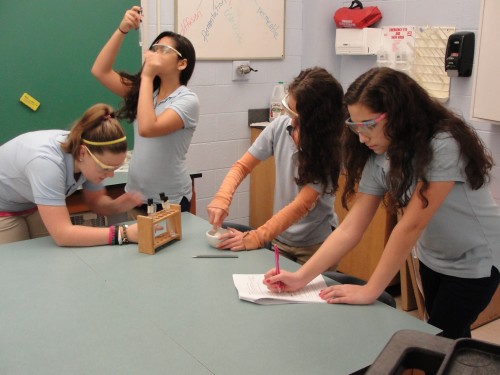
Co-Principal Investigators Vanessa Lugo, Nikki Markakis, Alexandra Pasamihalis, and Madison Pignatelli in Mrs. Fisher’s 8th grade class experiment with their reactants while completing their proposal.
Summary:
We want to determine if the eggshell disintegration rate in vinegar differs in the presence of gravity and microgravity so we can infer the damage acids will have against our teeth in space. We believe that the eggshells will dissolve quicker in space. Some facts that we learned from this research are that vinegar contains 3% acetic acid. Eggshells contain calcium carbonate. The two substances react and form carbon dioxide. Also the eggshells are like our teeth because they are both made out of stone-like minerals and mostly of calcium. The topic interests us
because eggshells and teeth both contain calcium carbonate and the reaction of acid to the eggshells may represent teeth and the affects of acids on them. We are hoping to learn the effect of the vinegar on the eggshells in comparison to teeth and food acids. The resulting information can help in the development of dental products in order to protect teeth from acidic foods while in space.
Partner Institutions
Pennsauken Township Public Schools
The Dow Chemical Company
Center for the Advancement of Science in Space (CASIS) – SSEP National Partner
Subaru of America, Inc. – SSEP National Partner
PSE&G
Universal Technical Resource Services
Toth Technologies
J&J Snack Foods
For More Information, Visit Pennsauken’s Mission 3 to ISS Community Profile
5. Willis, Texas
Germination of Cabbage Seed
Grade 5, A.R. Turner, C.C. Hardy, and Parmley Elementary Schools
Co-Principal Investigators: Kalysta Gutierrez and Selma Nieniel
Co-Investigators: Danielle Pierce and Safira Reyes
Collaborators: Daniel Perez and Leiloni Zachary
Teacher Facilitators: Michelle Brown, Janet Lindsey, and Rachel Rockwell, Science Teachers
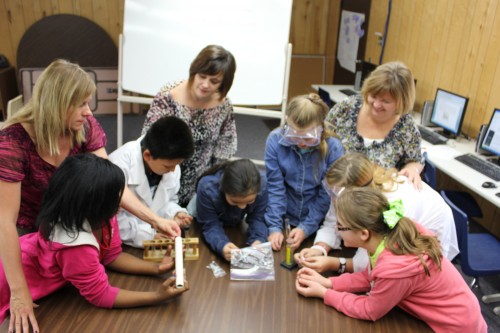
SSEP student flight team members and fifth grade science teachers begin setting up for their ground truth experiment.
Summary:
Our project is Savoy cabbage (Brassica oleracea var. sabauda) germinating in space. If the Brassica oleracea var. sabauda seed germinates in microgravity, it would be good for the astronauts because it would give them more nutrients and a source of fresh produce. We chose Savoy cabbage seeds for our experiment because it is rich in Thiamin, Calcium, Iron, Magnesium, Phosphorus and Potassium, and a very good source of Dietary Fiber, Vitamin C, Vitamin K, Vitamin B6, Folate and Manganese. We hypothesize that Savoy cabbage seeds will germinate in microgravity.
Partner Institutions
Willis Independent School District
Center for the Advancement of Science in Space (CASIS) – SSEP National Partner
Protect Controls, Inc.
Summit Flow Controls, Inc.
For More Information, Visit Willis’s Mission 3 to ISS Community Profile
Mission 2 Re-Flight Experiment
Russell County, Virginia
The Rate of Oxidation in a Microgravity Environment
Grades 10-11, Lebanon High School
Co-Principal Investigators: Diana Odhiambo, Donna Odhiambo, Jacob Akers, and McKenna Collins
Teacher Facilitator: Jane H. Carter, Chemistry Teacher
Diana Odhiambo (2nd from left) explains her team’s experiment on the rate of oxidation of copper and iron in a microgravity environment during a local media day. Other team members are (left to right) Donna Odhiambo, Jakob Akers, and McKenna Collins. Click for Zoom
Summary:
It was hard deciding the experiment that we were going to conduct. So we came up with a guideline of what our question must be. It had to be relevant as a daily occurrence on earth while still having factors that would make it important to space and space travel as well. Using this guideline, we came up with the idea of oxidation. The metals that we chose to oxidize were iron and copper. We chose iron because of its use in many buildings and tools; if something made of metal was sent into space, it would most like be made of an iron alloy. In contrast, we chose copper because of its properties as a thermal and electrical conductor, not to mention the fact that it’s completely recyclable, which is very useful when there is a scarcity of resources, like in space. We decided that we should use water as the oxidizer. Since the corrosion of metals through oxidation happens because the hydrogen atoms in water bond with other elements which at times results in acids that corrode the metal. In a microgravity environment, the elements would still combine, however the water would be in contact with the metals less frequently. In addition, water’s adhesion property wouldn’t be applicable, so once in contact with the metal, water would not cling to it. This would undoubtedly lower the rate of oxidation. In conclusion, if we send the iron, copper, and water into space, then the oxidation rate will be slower.
Partner Institutions
Russell County Public Schools
Lead: Lebanon High School
Virginia Space Grant Consortium
Dominion Resources
CGI Technologies and Solutions
Verizon
Alpha Natural Resources
Russell County Board of Supervisors
Southwestern Virginia Technology Council
Northrop Grumman
Virginia Tech Southwest Center
Crutchfield
For More Information, Visit Russell County’s Mission 2 to ISS Community Profile
Team Oral Presentation, 3rd Annual SSEP National Conference, July 2013
Mission 1 Re-flight Experiment
San Marino, California
Effect of Microgravity on the Antibacterial Resistance of P. aeruginosa
Grade 10; San Marino High School
Principal Investigator: Martin Liu
Co-Investigators: Kristie Liu, Ryan Puri, and William Tam
Teacher Facilitator: Joseph Kealoha Carmona, Biological Sciences
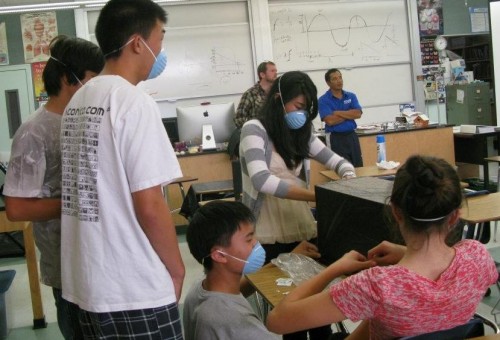 Summary:
Summary:
Throughout human history, bacteria and disease have been prevalent in every civilization. Modern medicine took its largest leap with the discovery of the first safe antibiotic: penicillin. As the world’s nations begin eyeing the depths of the final frontier, they must ensure the safety of the pioneers sent into space. Aboard the Apollo 13 mission, Fred Haise was infected by bacteria known asPseudomonas aeruginosa, which survived in the water tanks aboard the space shuttle. P. aeruginosa is capable of living in nutrient deprived places, like dirt and distilled water, and is deadly to those with compromised immune systems. Its deadliness is not scientists’ only concern; P. aeruginosa is resistant to many common antibacterial agents, penicillin being one of them. Now that space travel is becoming more common, we must take more precaution to ensure the safety of our astronauts from the smallest of killers. By growing two samples of P. aeruginosa, one in space and one under the influence of gravity, and submitting both to various antibiotics, we are able to measure the antibacterial resistance of both cultures. The zones of inhibition, where the bacteria are unable to grow due to the antibacterial agent, accurately show how resistant P. aeruginosa is to each antibiotic. Any variation in the zones of inhibition of the same antibiotic between cultures would be due to any changes that occurred in the bacteria’s resistance when grown in space.
Partner Institutions
Lead: San Marino Unified School District
San Marino High School PTSA
For More Information, Visit San Marino’s Mission 1 to ISS Community Profile
Team Oral Presentation, 3rd Annual SSEP National Conference, July 2013
New PI and Co-I Team
Team Oral Presentation, 2nd Annual SSEP National Conference, July 2012
Original PI and Co-I Team
The Student Spaceflight Experiments Program (SSEP) is a program of the National Center for Earth and Space Science Education (NCESSE) in the U.S., and the Arthur C. Clarke Institute for Space Education internationally. It is enabled through a strategic partnership with NanoRacks LLC, working with NASA under a Space Act Agreement as part of the utilization of the International Space Station as a National Laboratory. SSEP is the first pre-college STEM education program that is both a U.S. national initiative and implemented as an on-orbit commercial space venture.
The Smithsonian National Air and Space Museum, Center for the Advancement of Science in Space (CASIS), Carnegie Institution of Washington, NASA Nebraska Space Grant Consortium, and Subaru of America, Inc., are National Partners on the Student Spaceflight Experiments Program.

